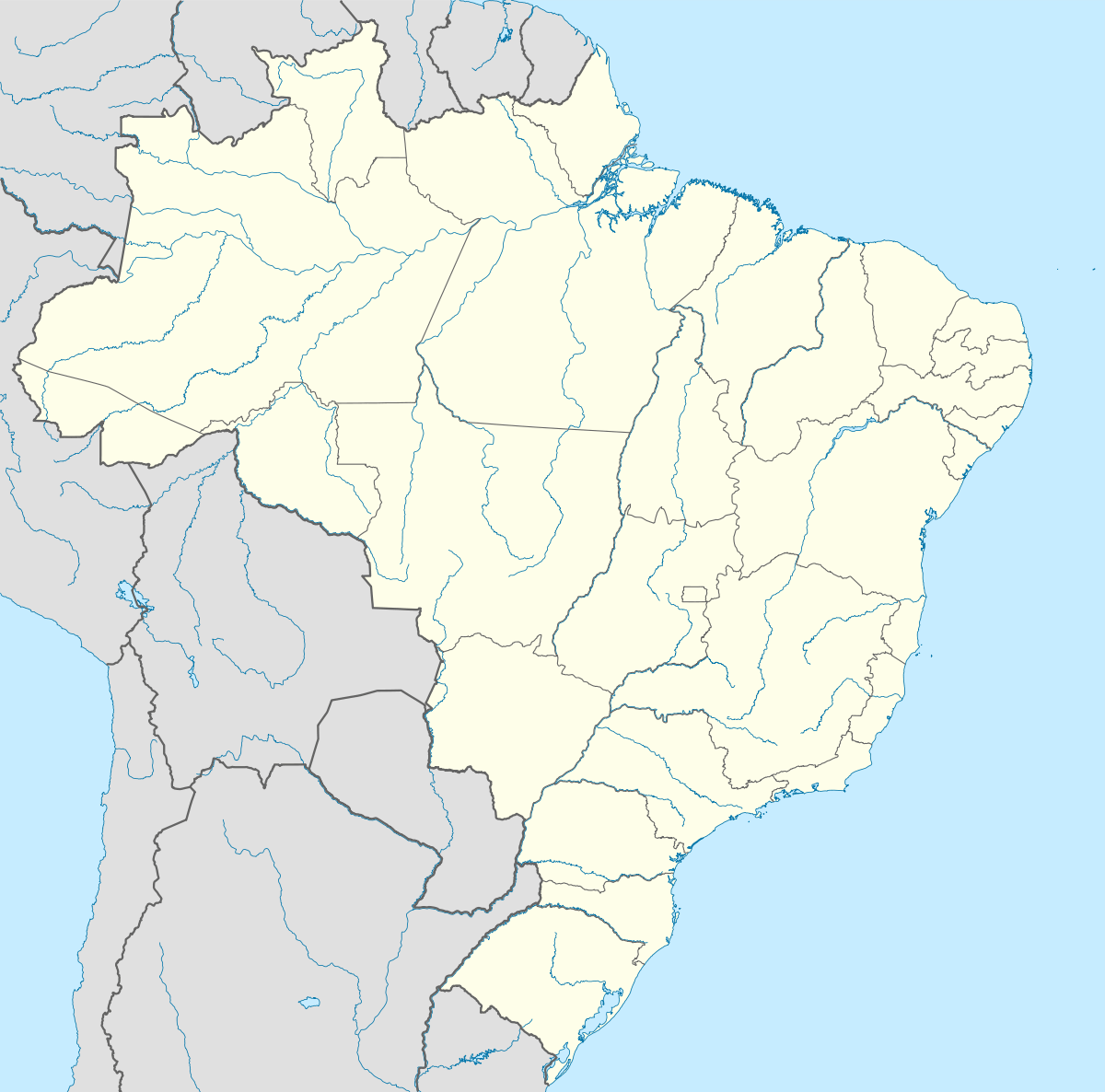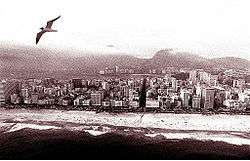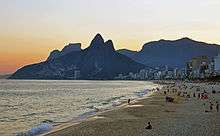Ipanema
| Ipanema | |
|---|---|
| Neighbourhood | |
 Ipanema  Ipanema Location in Rio de Janeiro | |
| Coordinates: 22°59′01″S 43°12′16″W / 22.98361°S 43.20444°WCoordinates: 22°59′01″S 43°12′16″W / 22.98361°S 43.20444°W | |
| Country |
|
| State | Rio de Janeiro (RJ) |
| Municipality/City | Rio de Janeiro |
| Zone | South Zone |

Ipanema (Portuguese pronunciation: [ipaˈnẽmɐ]) is an affluent neighbourhood located in the South Zone of the city of Rio de Janeiro (Brazil), between Leblon and Arpoador. The beach at Ipanema became widely known by the song "The Girl from Ipanema" ("Garota de Ipanema"), written by Antônio Carlos Jobim and Vinícius de Moraes.
Etymology
The word "Ipanema" comes from the Tupi language and possibly means "stinky lake", from upaba ("lake") and nem ("stinky") or "bad water; river without fish" from "y" (water) and "panema" (bad).[1][2][3]
History
Ipanema today consists mostly of land that once belonged to José Antonio Moreira Filho, Baron of Ipanema. The word "Ipanema" did not refer originally to the beach, but to the homeland of the baron at São Paulo. Ipanema gained fame with the rise of the popular bossa nova sound, when residents Antônio Carlos Jobim and Vinicius de Moraes created their ode to the neighbourhood, "The Girl from Ipanema." The song was written in 1962, with music by Jobim and Portuguese lyrics by de Moraes; English lyrics were written later by Norman Gimbel. Its popularity has seen a resurgence with Diana Krall's song "Boy from Ipanema", released in 2008.
Character

Ipanema is adjacent to Copacabana and Leblon Beach, but it is distinct from its neighbour. It is relatively easy to navigate because the streets are aligned in a grid. Ipanema is one of the most expensive places to live in Rio, and private investment has led to the building of world-class restaurants, shops, and cafes. At the forefront of its beach culture are the many surfers and sun worshipers who socialise daily at the beach. Every Sunday, the roadway closest to the beach is closed to motor vehicles allowing local residents and tourists to ride bikes, roller skate, skateboard, and walk along the ocean.
Ipanema has played a role in the culture of Rio de Janeiro since its beginning, with its own universities, art galleries, theaters and cafes. It holds a street parade, the Banda de Ipanema, during Carnival festivities, separate from those of Rio de Janeiro, attracting up to 50,000 people to the streets of Ipanema.

Beach
The beach at Ipanema is known for its elegant development and its social life. Two mountains called the Dois Irmãos (Two Brothers) rise at the western end of the beach, which is divided into segments delineated by postos, or lifeguard towers. Beer is sold everywhere, along with the traditional cachaça. There are always circles of people playing football, volleyball, and footvolley, a locally invented sport that is a combination of volleyball and football.
In the winter the surf can reach nine feet. The water quality varies from clear light-blue water to a more murky green after heavy rains. Constant swells help keep the water clean, and the often treacherous beach break regularly forms surfable barrels. Just west of this colorful section, towards Leblon, Rio de Janeiro, is another popular stretch of sand known as Posto 10, referring to the #10 lifeguard station.
The beach is one of many areas that suffers from the city's poor waste treatment. In its waters, "fecal coliform bacteria sometimes spike at 16 times the Brazilian government's 'satisfactory' level."[4] Large amounts of pollutants are still dumped into the sea through the nearby marine outfall pipe, a matter of increasing concern to ecologists.[5]
Beachgoers often applaud the sunset in the summer.[6] The Travel Channel listed Ipanema Beach as the sexiest beach in the world.
Posto 9

Posto 9 is the section of the beach around the #9 lifeguard station, across from Joana Angelica Street. Its notoriety began around 1979 when Fernando Gabeira, now a federal deputy for the State of Rio de Janeiro, returned from political exile in France and was photographed there in a thong.[7] He had been a member of the leftist urban guerilla group MR8, which kidnapped the American ambassador, Charles Burke Elbrick, in 1969 and demanded the release of fifteen political prisoners in exchange for his life.[8][9]
Gabeira became a political celebrity with the publication of a memoir about his experiences as a guerilla and his years in exile. In 1979, he was photographed wearing a skimpy purple swimsuit at Ipanema, and gave an interview to a gay and lesbian newspaper, inciting rumors that he was gay, which he neither confirmed nor denied. His going to the beach at Posto 9 made it famous throughout the country.[7][10]
Posto 9 inherited its status as a gathering spot for counter-cultural types from the area near Farme de Amoedo Street, next to the dunes called Dunas do Barato and a pier that was demolished in the 1970s. It has a long history of public pot smoking (illegal in Brazil), police raids, and gatherings of left-wing intellectuals. It is still popular with students, artists, actors, and liberal-minded people.
Feira Hippie de Ipanema - Ipanema Hippie Market
A group of hippies started a Sunday market in Ipanema in 1968 and the traditional fair continues with over 700 stalls set up at the Feira Hippie de Ipanema.
References
- ↑ "Curso De Tupi Antigo". Fflch.usp.br. Retrieved 2012-09-10.
- ↑ "Língua guarani". Girafamania.com.br. 2011-10-17. Retrieved 2012-09-10.
- ↑ "Areia de Praia". Areiadepraia.wordpress.com. Retrieved 2012-09-10.
- ↑ Ravenscroft, Nick (2 January 2014). "Filthy waters around Rio spark safety fears for Brazil Olympic sea sports". ITV News. ITV plc. Retrieved 25 May 2016.
- ↑
- ↑ Robinson, Joe (24 July 2013). "8 of Brazil's best beaches". CNN.com. Retrieved 17 September 2014.
Beachgoers in Rio de Janeiro have been known to break into applause as the sun sets after a particularly fine day of bronzing.
- 1 2 Zuenir Ventura (1 January 2005). Minhas histórias dos outros. Planeta. p. 117. ISBN 978-85-7665-076-8.
- ↑ Rebecca J. Atencio (25 June 2014). Memory’s Turn: Reckoning with Dictatorship in Brazil. University of Wisconsin Press. pp. 33–34. ISBN 978-0-299-29724-4.
- ↑ Thomas E. Skidmore (8 March 1990). The Politics of Military Rule in Brazil, 1964-1985. Oxford University Press. p. 500. ISBN 978-0-19-028167-0.
- ↑ Rebecca J. Atencio (25 June 2014). Memory’s Turn: Reckoning with Dictatorship in Brazil. University of Wisconsin Press. pp. 39–40. ISBN 978-0-299-29724-4.
External links
| Wikimedia Commons has media related to Ipanema. |